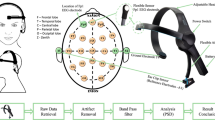Abstract
For the patients with limb disorder to control the home robot movement, the human intention sensing and encoding are the two important tasks. This paper focuses on a new augmented reality brain computer interface (ARBCI) of the stable state visual evoked potential (SSVEP), the human intention recognition algorithms using SSVEP and Electra-hologram (EOG) respectively, and the encoding design of the human intentions. Firstly, the new ARBCI is developed which includes the SSVEP collector and a specific environment augmented reality stimulator of the symbols of the robot operations. Furthermore, the robot control instructions are encoded. Secondly, the sliding window superposition-average algorithm (SWSA) is proposed for human intention recognition on the basis of SSVEP. The stimulation frequency feature from the augmented reality stimulator is extracted by using SWSA to control the power supply and the robot speed. Thirdly, the intentional blinking EOG threshold is defined according to the experiments. Then, a fusion recognition (FR) algorithm of amplitude and sampling time is developed on the basis of EOG, which is for the home robot direction controls. It is experimentally proved that the ARBCI improves the eye comfort compared with that of the original BCI stimulator. Besides, the SWSA can save 4 s to sensing a SSVEP intention meanwhile keep the same recognition accuracy compared with the traditional superposition-average method. In addition, the human intention sensing accuracy can reach 100% by using ARBCI and SWSA and the FR if the sensing time is adequate. A EOG intention sensing time is about 0.5 s by using the FR algorithm.












Similar content being viewed by others
References
Abdullah JH, Al G, Nasir AA, Malik AA (2015) Sugeno fuzzy PID tuning by genetic-neutral for AVR in electrical power generation. Appl Soft Comput 28:226–236
Chae Y, Jeong J, Jo S (2012) Toward brain-actuated humanoid robots asynchronous direct control using an EEG-based BCI.IEEE Trans on robot 25:11131-11144
Diez F, Mut A, Avila Perona E et al (2011) Asynchronous BCI control using high-frequency SSVEP. J Neuro Engineering Rehabil 8:39–46
Doron F, Leeb R, Pfurtscheller G, Slater M (2010) Human-computer interface issues in controlling virtual reality with brain-computer interface. Hum Comput Interact 25:67–94
Huimin L, Yujie L, Shota N (2015) Single image dehazing through improved atmospheric light estimation. Multimedia Tools Appl 75(24):17081–17096
Huimin L, Yujie L, Xing X (2016) Underwater image enhancement method using weighted guided trigonometric filtering and artificial light correction. J Vis Commun Image Represent 38:504–516
Jiaxin M, Yu Z, Cichocki A, Matsuno F (2015) A novel EOG/EEG hybrid human-machine interface adopting eye movements and ERPs: Application to Robot Control. IEEE Trans Biomed Eng 62:876–889
Jung-Hoon K, Sun L, Il-Kyun J (2012) Ether CAT based parallel robot control system. Robot Intell Technol Appl 208:375–382
Lu H, Li B, Zhu J et al (2016) Wound intensity correction and segmentation with convolutional neural networks. Practice and Experience, Concurrency and Computation. doi:10.1002/cpe.3927
Luzheng B, Xin’an F, Nini L, Ke J, Yun L, Yili L (2013) A head-up display-based P300 brain-computer interface for destination selection. IEEE Trans Intell Transp Syst 14:1996–2001
Luzheng B, Xin’an F, Teng T, Hongsheng D, Yili L (2014) Using a head-up display based steady state visual evoked potentials brain-computer interface to control a simulated vehicle. IEEE Trans Intell Transp Syst 15:959–966
Masataka Y, Chi Z, Kazuyuki I, Feng W, Haoyong Y (2014) Experimental design and signal selection for construction of a robot control system based on EEG signals. Robot Biomim 1:22–33
Pan J, Li Y, Gu Z, Yu Z (2013) A comparison study of two P300 speller paradigms for brain–computer interface. Cogn Neurodyn 7:523–529
Shih Chung C, Chih Hung H, Hsuan Chia K (2014) The BCI control applied to the interactive autonomous robot with the function of meal assistance. Lect Notes Elect Eng 345:475–483
Volosyak I, Valbuena D, Lüth T, Malechka T, Gräser A (2011) BCI demographics II: how many (and what kinds of) people can use a high-frequency SSVEP BCI? IEEE Trans Neural Syst Rehabil Eng 19:232–239
Xinyu W, Chenguang Y, Zhaojie J, Hongbin M, Mengyin F (2016) Robot manipulator self-identification for sursegmenting obstacle detection. Multimed Tools Appl. doi:10.1007/s11042-016-3275-8
Yuchae J, Yong-IK Y (2016) Multi-level assessment model for wellness service based on human mental stress level. Multimed Tools Appl 5:1–13
Yujie L, Huimin L, Jianru L (2016) Underwater image de-scattering and classification by deep neural network. Comput Electr Eng 54:68–77
Zolotukhin Y, Kotov K, Maltsev A (2011) Correction of transportation lag in the mobile robot control system. Optoelectronics Instrum Data Process 47:141–150
Acknowledgments
This research was sponsored by the Natural Science Foundation of China (51405381), Key Scientific and Technological Project of Shaanxi Province (2016GY-040), and the Science Foundation of Xi’an University of Science and Technology (104-6319900001).
Author information
Authors and Affiliations
Corresponding author
Rights and permissions
About this article
Cite this article
Wang, M., Qu, W. & Chen, WY. Hybrid sensing and encoding using pad phone for home robot control. Multimed Tools Appl 77, 10773–10786 (2018). https://doi.org/10.1007/s11042-017-4871-y
Received:
Revised:
Accepted:
Published:
Issue Date:
DOI: https://doi.org/10.1007/s11042-017-4871-y




